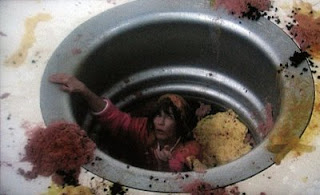When I saw a Pin about cutting a glass bottle with fire I immediately ran around the house to find all the materials I needed. Maybe I should be slightly concern with out excited I was to play with fire.
Cutting Glass Bottles
You Will Need:
glass bottles
yarn
nail polish remover
lighter
sink full of ice water
sandpaper
Directions:
Wrap the cotton yarn around your bottle 5-6 times, tie and cut ends. You can also braid three pieces together and tie that around the bottle. Slide yarn off of the bottle. Dip yarn in nail polish remover. I filled a bowl with nail polish remover and let the yarn sit in it for a few seconds to make sure it was fully saturated. Slide the wet yarn back onto the bottle. NOTE: The bottle will be cut wherever you place the yarn, so make sure it is as straight as possible. Holding the bottle sideways from the mouth, light the yarn on fire. ****Please please be careful!**** Only the wet yarn will be lit on fire and the flame is very well controlled. Rotate the bottle in circles as the yarn is on fire for 20-30 seconds so that all parts of the bottle warm evenly. Holding each end of the bottle, submerge in cold water and watch the bottle parts separate. Use sand paper to smooth rough edges.
The only glass bottle I had in the house was a maple syrup bottle. I didn't have cotton yarn so I grabbed regular string and...... long story short it didn't work. You have to use cotton yarn in order for this to work.
So I loaded up the kids and went to the store. Yep, I loaded up two kids to drive to the store just to get some yarn. Seriously, I might have a problem.
After wrapping the yarn around the bottle a few times, I took it off then soaked it in nail polish remover. I then forced the yarn back onto the bottle.
I sent the kids outside, grabbed the lighter and the fireworks began.
Check out the massive flame. I was a bit worried and was really glad that I was holding it over a sink full of water just in case things got out of control.
I rotated the bottle in a circle until the flame died out. It was around 25 rotations. I dunked the bottle into the ice water, grabbed the other end and pulled. It was the strangest feeling. If felt like gum was holding the two pieces together, so the pieces sort of oozed away from each other then suddenly popped off.
The Verdict: Ummm, clearly something went wrong. Instead of a nice drinking glass, I got a torture device.
You mean I get to try again!!!! Awesome!!!! (is there a pyro anonymous group?) I didn't have any other glass bottles so I asked my neighbor if she had some old ones kicking around. Fortunately for me, she did.
I went through the same method, and the first dunk into the water nothing happened. So I
The Verdict: Much better. The cut spot is a bit uneven but at least there aren't horrible jagged edges.
I used a really fine grit of sand paper to sand around the edges and it smoothed up nicely. I would still be a bit nervous drinking out of it, but I think it's more of a physiological fear.
I dont' know if my first bottle failed because of the type of glass, but this could be a fun way to make things like vases or center pieces, just be prepared for it to take a few tries to get it right.
























.JPG)

























